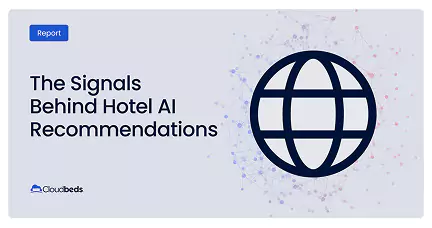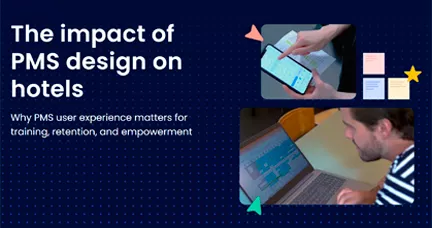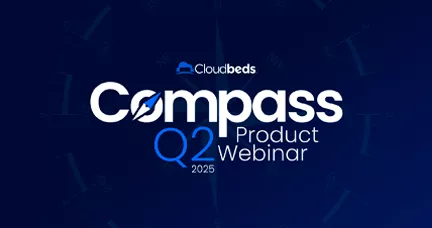Our 2025 PMS User Experience report revealed a staggering truth: the hospitality industry is running on a 40.5% churn rate. Across five countries, churn was lowest in Canada (28%) and highest in the US (50%).
Between January and April 2024 alone, nearly 3 million people walked away from leisure and hospitality jobs — more than double the national average.
This isn’t normal attrition. It’s a labor crisis. Hotels are fighting to fill roles, stretching teams thin, and watching higher wages and constant churn eat into profits.
In this guide, we break down what hotel turnover really costs and how managers can fight back with strategies and technology that ease the pressure on staff and keep the business moving forward.
What is hotel turnover?
Hotel turnover is when staff resign or are let go from working at a property. In the hospitality industry, hotels experience the highest turnover rates, more than all other economic sectors.
Staff turnover occurs due to several factors, including labor shortages and job demands. Seasonality can also affect your accommodation’s turnover. As many properties shift from low season to high season and back again, so too do your staff requirements.
Another reason employees depart includes a lack of growth opportunities (perceived or actual). Without a clear growth plan, employees are more likely to seek job opportunities elsewhere for career development and advancement.
One component that plays into this is insufficient training. When employees lack confidence, they feel more unprepared to take on advanced roles (rightfully so). This extends to their inexperience with hotel tech solutions like a property management system (PMS). 38% of employees say their experience with the PMS played a role in their decision to leave a job.
The state of turnover in 2025
Hotel turnover has significantly increased since the COVID-19 pandemic as a result of changing staff expectations. Stagnant wages and increased workloads drive workplace dissatisfaction, leading to increased strike action.
High turnover is incredibly costly to general managers, who experience a repetitive cycle of recruitment, hiring, and training processes for new employees. Many hotels rely on outdated technology systems with poor user experience, resulting in prolonged in-person training periods, which can turn into a near-continuous process.
To combat these challenges, hotels must rethink their approach to staff retention by fostering a positive workplace culture, providing competitive benefits, and leveraging modern technology to streamline operations and empower their teams.
The impact of turnover on hotels
The real cost of high turnover rates for hoteliers manifests in numerous ways, both financial and operational. The longer you let these sources of hotel turnover fester, the more your property and guests suffer as a result.
Identifying primary causes of high turnover helps you to address them and implement strategies to improve your processes and increase both staff and guest satisfaction.
Financial costs
According to benchmarking data from the Society for Human Resource Management (SHRM), the average cost to hire an employee is nearly $4,700. However, this can be three to four times the initial salary band, depending on the new staff member.
As employee churn increases from season to season, so too do the increased costs associated with recruiting and training new team members.
Operational challenges
Hotels that experience high employee turnover rates can expect service quality gaps to form due to understaffing or inexperienced employees.
While the resulting expectation from hotel managers may be for experienced staff to take on more duties, straddling tenured employees with increased workloads and long hours is more likely to lead to burnout, decreasing your number of viable staff even further. Not only does this negatively impact existing staff whose loyalty already lies with your property, but it can also be indicative of more significant problems like poor communication and management.
Inconsistent guest experiences
Hotel turnover increases inconsistencies in the overall guest experience your hotel presents to visitors.
A constant influx of rotating staff being trained and onboarded can lead to gaps in service expectations, in turn leading to unpleasant experiences for guests and negative reviews. This is especially the case for guests accustomed to a certain level of attention and treatment.
Turnover rate calculation
Turnover rate is calculated by determining the percentage of hospitality workers who leave during a specific period.
The formula is:
Turnover rate = (# of employees who left during a period / Average number of employees during the same period) x 100
Let’s break down a scenario of 15 front desk employees over the course of a year.
- Starting number of employees: 15
- Ending number of employees: 12
- Number of employees who left during the year: 5
First, we’ll calculate the average number of employees during the period by adding the starting and ending number of employees, then dividing by 2.
Average # of employees = (15+12) / 2 = 13.5
Next, we’ll divide the number of employees who left by the average number of employees and multiply by 100.
Turnover rate = (5/13.5) x 100 = 37.04%
A turnover rate of less than 10% is considered “good” regardless of industry – but as we know, hospitality experiences much higher rates, and therefore, this number should be benchmarked against your own internal standards and compset.
3 ways to mitigate hotel turnover
While there’s no one fix for hotel turnover—it’s inevitably part of the industry—there are strategies hotels can test to reduce churn.
On The Turndown, Diego de Ponga, CEO of Port Hotels, shared how he is addressing these challenges across his 11 properties.
Leadership lessons from revenue management to the C-Suite.
Invest in training and development
Giving your staff ample opportunities to grow personally and professionally increases their desire to remain a part of your team. When employees have a clear vision for their career path and see you’re willing to invest in training programs and professional development, the higher the likelihood they’ll stay.
As part of fostering career progression and development opportunities, it’s important to include technology understanding and adoption. Our report found that when employees feel confident in their PMS skills, they are not only more likely to take on advanced roles but are also more inclined to remain with their current employer.
Investing in the right systems, checking in with staff regularly, and empowering them with training support and resources (like standard operating procedures and learning hubs provided by your technology vendors) help to keep their knowledge fresh and confidence high.
Foster a positive workplace culture
When your staff experiences an inviting workplace environment with team-building among co-workers, you create a more harmonious workplace. It can also boost employee mental health and well-being, which is often damaged by factors like job insecurity or negative work environments.
Arrange cross-functional events and collaboration, where staff across teams shadow their fellow employees for a day of learning. This provides a glimpse into diverse employee experience and boosts connection and morale.
These initiatives also present a wider view of the different roles available within a hotel ecosystem. By expanding your team’s horizons on what’s possible within hospitality (like becoming a commercial leader or engineering manager), you can entice employees to grow within your hotel.
Competitive compensation and benefits
Your staff work hard to make your hotel operations a thriving success and create amazing guest experiences. So compensate them accordingly! While a lot of compensation is monetary, there are other ways to show your appreciation.
To satisfy employees, it’s important to understand what your team values. As Gen-Z becomes more prominent in the workforce, consider their expectations and preferences. They value:
- Market-reflective wages
- Ample healthcare coverage
- Mental health programs
- Flexible scheduling (including remote work and flexible hours)
These benefits and incentives create loyalty between your team members and your property and promote a healthy work-life balance.
The role of technology in managing turnover
While technology won’t “solve” turnover, investing in the right technology can help you tackle some key challenges. In fact, intuitive tools boost employee morale and confidence in their roles, leading to greater guest satisfaction.
Investing in user-friendly tools that automate mundane tasks increases productivity and satisfaction. It also helps hotels facing labor shortages get more done with fewer resources.
A well-designed PMS reduces time and training costs while simplifying and improving the overall onboarding experience. This helps staff feel confident in their roles quicker, boosts work environment satisfaction, and improves employee retention. It’s important to find a vendor that supports your team members with this training process, including access to live support, videos, tool tips, and more.
How Cloudbeds helps with employee retention
Using a PMS like Cloudbeds that prioritizes human-centered design transitions your staff from repetitive, manual work to strategic, guest-centric work, in turn boosting morale, engagement, and long-term loyalty.
The platform’s well-designed, user-friendly PMS helps hotels:
- Reduce training time for new staff – increasing confidence in system processes and reducing onboarding time by 88%.
- Streamline workflows to minimize repetitive tasks – leading to increased functionality and higher job satisfaction.
- Enables career progression – the less tedious, manual work, the more you can invest in your team’s career progression, in turn boosting your retention rates.
“Cloudbeds’ ease of use also saves valuable time when it comes to training staff, with most new team members comfortable using the software in just three days,” shares Marco Leibundgut, Co-owner and Host of Bogentrakt Hostel.
What’s more, Cloudbeds is introducing multi-modal AI into the platform, making it easy for hotels to process and integrate different data types and formats simultaneously. This significantly supports faster onboarding and training for employees.
Known for its intuitive design, customers switching to Cloudbeds report:
- 50% reduction in training times
- Ability for front desk to manage shifts alone in 2 weeks
- 80% time saved on manual processes
- Streamlined staffing levels and easier upskilling of employees
Ease hotel turnover with Cloudbeds
Turnover hits hotels harder than most industries. Every staff member lost adds costs, slows operations, and weighs on the team that remains. The way forward is creating an environment where people want to stay. That means clear systems, a supportive culture, and technology that makes work easier. Cloudbeds gives managers a platform that lightens the load and helps hotels hold onto the people who make the difference.
Keep your team supported with Cloudbeds.
Published on 29 January, 2025 | Updated on 28 August, 2025



